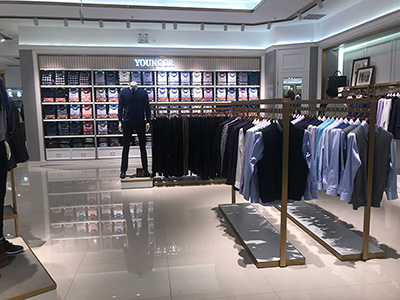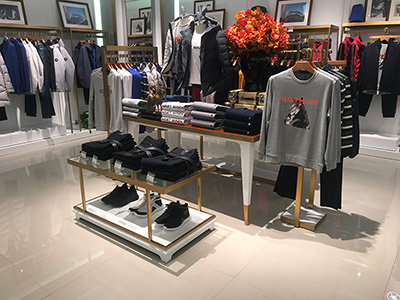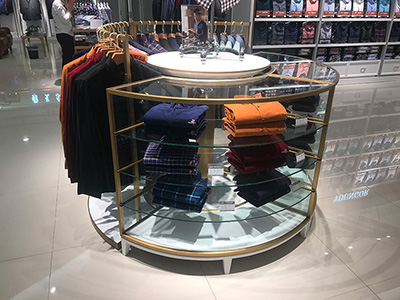28 Dec 2019
Clothes are natural in human being’s life. It can be said that it is one of the most important elements in life. Every single period has its special clothing. With the decoration of different kinds of clothes, we can be confident in different fields. In this way, clothing display racks can be considered as the cultural expression. It connects the designers’ thinking and the wish of the customers. They start to know about the clothes through the ways of display.

Talking about the clothing culture, we can’t ignore the history of Han Fu. Han Fu has a long history of more than three millennia. It is also said to have been worn by the legendary Yellow Emperor. In other words, as early as the era of the Yellow Emperor, ancient Chinese costumes have been on quite a scale. The Shang Dynasty developed the rudiments of Han Fu. It consisted of a narrow-cuffed, knee length tunic flied with a sash, and a narrow, ankle-length skirt, a length of fabric that reached the knees. Vivid primary colors and green were used, due to the degree of technology at the time. Chinese rules of etiquette regarding Han Fu started taking shapes in the Zhou Dynasty, regulating from royalties down to the commoners. Chinese clothing developed rapidly during the Wei and Jin and Southern and Northern dynasties. Some time before 265, the cultural and aesthetic views of the peoples in south and north China merged following mass movements of the population caused by frequent wars. Philosophical schools of thought influenced both people’s lives and the concepts of clothing design. Under that condition, the clothes have the special meanings at that time. During Sui Dynasty, all poor people had to wear black and blue clothes, and only the rich people could wear other colors. In Tang Dynasty, clothing was more varied than before because the state was more open to the outside world. People started to introduce western clothing to China. What’s worth special mentions is that women of Tang Dynasty did not have to aside by traditional dress code. They were allowed to expose their arms and back. Also, they were allowed to dress that absorbed elements from other cultures. They could wear man’s riding garments if they liked. The cloths for women, in particularly, changed rapidly. When a new style appeared, many people followed. They want to be the leader of that period so they keep up with the step of the changes of the clothing. Casual wearing appeared during the Song Dynasty. The cloths were simple and elegant. But during this dynasty, it became fashionable for women to bind their feet in order to keep them small. Women were thought to be more beautiful with their tiny feet which were only three inches long. Nowadays we can’t imagine that the tiny feet were so terrible. During the Yuan Dynasty, the Mongolian ethnic group, known as the people on horseback, was in power. The simple and unadorned style of clothing was mainly a combination of Mongolian and Han influences. Dramatic changes took place during the Ming Dynasty. There was no limitation to one style and natural beauty was advocated, thus bringing vigor and vitality to clothing culture. At the time of Republic Period, the Sun Yat-sen suit was popular around the country. It was introduced into China from western countries. We can say, the changes of the clothing are also the changes of the society. We learn from other countries and it is good to the both. At the first, the symbol of it is the closed stand collar and the center-front buttons. Later it incorporated the elements of German military dress including a turndown collar and four symmetrically placed pockets. Over time, they were further modified and adopted as China’s national dress.

As we can see, the culture of clothing changes as the time went by. Every single occasion has its special expression of clothing. Under the special background of the period, it may take people into the different ways of thinking. But who plays the important role as cultural expression? It is the clothing display racks. We can’t ignore the practical use of the clothing display racks.
Nowadays, in the clothing store, usually the first impression is very important. Customers may judge the quality of the clothes from these follow ways. Firstly, the decoration. If the decoration is perfect enough, they may have a strong will to enter in. Putting more plants and design the comfortable lights. What’s more important, the choice of clothing display racks is necessary. The clothing display racks can not only afford the opportunity to sell the clothes, but also as a role of decoration. Certainly, it is the role as cultural expression. It can show the aim of design to the customers. Secondly, the environment. People can never refuse the clean and beautiful environment. So always keep the place clean. Thirdly, the clothes themselves. Make sure that your clothes in the clothing store are placed properly. Tidy up the clothes and make full use of the clothing display racks. The good combination of the clothing display racks and the clothes can give the customers a good impression. Under that condition, they start to consider to buy them.

Culture is a common thinking that may gradually affect what you do. We live in a society with different kinds of people and we accept different kinds of ideas every day. New things are everywhere. What we should do is to catch up with them and try to be the leader in our life. It is the clothing display rack that connect customers and the clothing designers. In this way, clothing display racks can be considered as the cultural expression. It expresses the designers’ thinking to the customers. The design of the clothes has its own aim. If you are the shopkeeper, pay more attention to choose the proper clothing display racks. Well begun, half done. Let’s make our clothes have their special cultural meanings.
Keywords: clothing display racks
Originally published 28 Dec 2019, updated 28 Dec 2019.